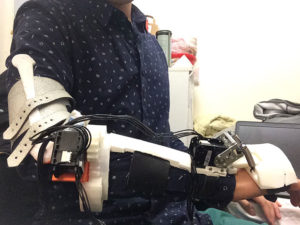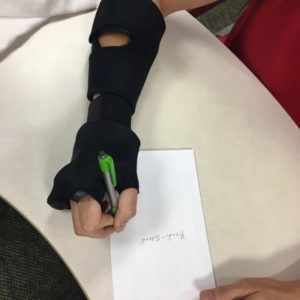The search for a medication that will control Essential Tremor (ET) is ongoing. ET is the most common movement disorder that primarily affects the hands but can also affect the head, voice and lower limbs. Though most prevalent in older adults, it can begin in childhood. It slowly becomes worse (progressive), and can severely compromise normal living. As disability becomes more obvious, the emotional realities of embarrassment, frustration and depression lead many persons to isolate themselves.
When first diagnosed with ET, almost all patients are offered pharmaceutical therapies like primidone, propranolol, and topiramate. Unfortunately, roughly half of them are disappointed by failure of the drugs to work for them. For those who have more success, the effect appears to weaken over time. Increasing the dosage often brings unacceptable side effects. When the drugs don’t work to begin with, or become less effective, or cause unpleasant side effects, what’s next? The neurologist may recommend Deep Brain Stimulation surgery or MRI-guided Focused Ultrasound. For some, this is daunting. Despite the hope of regaining the use of one’s hand(s), the reasons for resisting such a major intervention can range from fear to financial hardship. This is where devices may have a role to play.
Devices to control tremors
As the authors of a recent study point out, “Alternative therapies are then needed for individuals presenting ET who respond poorly to medication, and for those in which surgery is not possible. Therefore, there is a growing interest in nonpharmacological therapies and functional rehabilitation for ET.”i The team conducted a review of published literature and identified three types of assistive devices (NOTE: Inclusion of specific devices in this article is not an endorsement for a particular product, but only illustrative examples):
 Exoskeletons – wearable “mechatronic” systems that are placed on the body to work with the person and “act as amplifiers that augment, reinforce or restore human performance.”ii See prototype at right (source).
Exoskeletons – wearable “mechatronic” systems that are placed on the body to work with the person and “act as amplifiers that augment, reinforce or restore human performance.”ii See prototype at right (source). Orthotic devices that act in parallel to an affected part of the body and compensate for its disability. One example is the Readi-Steadi® anti-tremor orthotic glove, shown at right (source).
Orthotic devices that act in parallel to an affected part of the body and compensate for its disability. One example is the Readi-Steadi® anti-tremor orthotic glove, shown at right (source).- Handheld assistive devices such as eating utensils with stabilizing technology that counteracts the motion of tremors.
The authors identified 12 articles that reported experiments with various devices, most of which were prototypes, and all of which were directed to hand/arm tremors. Some controlled the entire arm including elbow, forearm and wrist; some were aimed at a single joint (either the elbow or the wrist). It was a challenge to create a meaningful summary and discussion due to several factors:
- Little information was given on device comfort and practical application to daily life activities and voluntary movement
- Insufficient knowledge of tremor origins, muscles involved, how it propagates to the hand
- Lack of agreement on the best arm/hand location to manage tremors
- Uncertainty over whether tremor frequency or amplitude is more disabling
- Lack of apples-to-apples study design (tasks to be performed, validated clinical measures of tremor control, etc.)
While underscoring the increasing interested in tremor management devices, the article concludes:
…the level of evidence regarding the efficacy of these tremor control devices remains low. An integrated multidisciplinary combination approach of engineering, robotics, physiology, physiotherapy, and clinical assessment is needed to improve the quality of nonpharmacological interventions for ET.
It seems that the search for a great device, like that for a successful drug(s), will continue for the foreseeable future. If you wish to look into tremor management devices, we recommend exercising due diligence (research and study products, consult with your neurologist, etc.) and make sure you familiarize yourself with the return policy if the product isn’t producing the hoped-for result.
i Castrillo-Fraile V, Peña EC, Gabriel y Galán JM, Delgado-López PD et al. Tremor Control Devices for Essential Tremor: A Systematic Literature Review. Tremor Other Hyperkinet Mov (N Y). 2019; 9: 10.7916/tohm.v0.688. Published online 2019 Dec 5.
i“Exoskeleton Report,” https://exoskeletonreport.com/what-is-an-exoskeleton/

